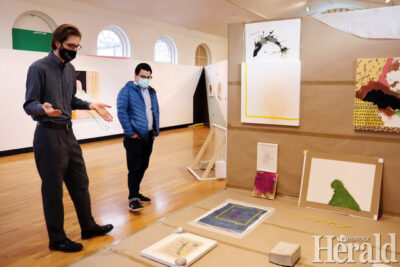Southern Alberta Art Gallery offering exhibition tours
By Alejandra Pulido-Guzman - Lethbridge Herald on January 13, 2022.
 Herald photo by Alejandra Pulido-Guzman
Southern Alberta Art Gallery curator Adam Whitford explains a portion of the Body Longing exhibit by local artist Mandy Espezel, to guided tour attendee Terrance Kutney.
Herald photo by Alejandra Pulido-Guzman
Southern Alberta Art Gallery curator Adam Whitford explains a portion of the Body Longing exhibit by local artist Mandy Espezel, to guided tour attendee Terrance Kutney.LETHBRIDGE HERALDapulido@lethbridgeherald.com
The Southern Alberta Art Gallery is now offering guided tours of their current exhibitions for those wondering about the history behind the works or art currently on display.
The guided tours are included with the admission fee and pre-booking is not required. Tours are being offered three times per week, on Wednesdays from 12:30 p.m to 1:30 p.m., Thursdays from 6:30 p.m. to 7:30 p.m. and Saturdays from 12:30 p.m. to 1:30 p.m.
And for those who are unable to attend the scheduled guided tours, or who would like to have a one on one tour, private guided tours are also available.
The guided tours cover three different areas of the gallery. The Main gallery, where those in attendance can learn about Under the Vast Sky by Swedish artist Britta Marakatt-Labba. The second location is the upper gallery space where Body Longing by Mandy Espezel is located, and the third area is the library where There Were Nothing But Pedigrees All Around Us by Luke Johnson is located.
The current exhibits will be on display until February 6, but the guided tours will resume once the new exhibits arrive.
A Lethbridge resident who works in the area took advantage of his lunch hour to take part of the guided tour offered by SAAG curator Adam Whitford on Wednesday, as he had previously visited the exhibit and wanted to know more about it.
“I really like the Britta Marakatt-Labba. I really appreciated the tour, I didn’t realize there were so many parallels between her work as a Sami artist and the kind of things that have been going on in Canadian history with Indigenous people,” said Terrance Kutney, guided tour attendee.
Britta Marakatt-Labba is a Swedish North Sami, who are the Indigenous peoples of Sweden and Norway.
Kutney said that after the tour, he feels like he appreciates her work a lot more with the connection that it has to Canada.
SAAG curator Adam Whitford explained the similarities between Sami people and Blackfoot people when talking about an art piece called The Crows embroidery that depicts a flock of crows that land downhill from Sami protestors sitting outside of their goahti huts and turn into black-clad policemen.
“The protesters built basically like teepees in protest (of the building of a dam) and camped out and chained themselves to this location and then police came to take them away,” said Whitford.
He added that Marakatt-Labba herself was one of them and while in the back of the police car, they checked her ID and realized she was from Sweden and she was in Norway and they would have to take her back, but she explained that for Sami people boarders do not mean anything, as their territory expands through Norway, Sweden and in parts of Russia and Finland.
“When thinking of the Sami history and culture, I don’t want to equate them, but that’s relatively similar to indigenous people in Canada, in the same way that Blackfoot people don’t really acknowledge or care that much about the US border with Canada, and the constructions of teepee looking structures that they would live in” said Whithford.
He explained other similarities shown in the 1986 embroidery named The Journey which shows Sami people going into a church, which in a similar way to Blackfoot and indigenous people in Canada, they were encouraged or forced to learn Christianity and there was boarding schools for them, which were similar to residential schools.
Follow @APulidoHerald on Twitter
4-3


